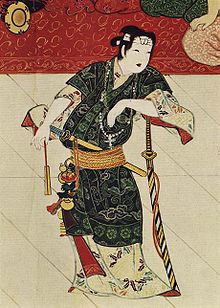Kabuki
Kabuki ( Japanese 歌舞 伎 "song and dance") is the traditional Japanese theater of the middle classes of the Edo period and consists of song , pantomime and dance . Kabuki is an essentially secular art form and something less formal than the older, from Buddhism influenced Noh Theater of the Samurai . Kabuki was inscribed on the UNESCO list of Masterpieces of the Oral and Intangible Heritage of Humanity (since 2008 Representative List of the Intangible Cultural Heritage of Humanity ) in 2005.
history

The art form was founded in 1603 by Okuni from the Izumo shrine , a Miko (shrine girl), when she and other women at the Kitano shrine in Kyoto performed dance and comedic pieces. The dance itself was based on the religious nembutsu odori ( 念 仏 踊 り , dt. "Dance to invoke the Buddha"), which she varied with erotic gestures, which gave this drama the name Kabuki - from kabuku "shocking; Lean forwards". This drama was quickly adopted by other groups, with prostitution often occurring, so that the Tokugawa shogunate in 1629 banned all women from the stage and thus the "women's kabuki" ( 女 歌舞 伎 , onna kabuki ). Thereafter, the groups consisted mainly of young men, with this "youth kabuki" ( 若 衆 歌舞 伎 , wakashū kabuki ) the same problem occurred and in 1652 this was also banned. After that, kabuki developed into a sophisticated, highly stylized male-only form, called "guy kabuki" ( 野 郎 歌舞 伎 , yarō kabuki ). The men who play the women are called onnagata ( 女 形 or 女方 , feminine form or feminine person ). They underline their roles with deliberately refined movements and a typical “ falsetto ” voice. The other two main styles, the male roles so to speak, are Aragoto ( 荒 事 , dt. "Hard style") and Wagoto ( 和 事 , dt. Roughly: "soft style"). The actors underline their roles with traditional make-up , costumes and voices. The appearance of the Aragoto was shaped by the actor Ichikawa Danjūrō I in Edo and the Wagoto by Sakata Tōjūrō I in the Kyōto- Osaka area ( Kansai region).
The pieces are divided into three categories: Jidaimono ( 時代 物 , German “historical piece”) , Sewamono ( 世 話 物 , German “bourgeois piece”) and Shosagoto ( 所作 事 , German “dance piece”). Most of the pieces, however, are about samurai .
The performance
An important feature of Kabuki is the mie ( 見得 ), a characteristic pose of the performer. Inexpensive color prints with Mie, the characteristic poses of the actors who often had a whole retinue of admirers, including ladies and courtesans of the Shogunate palace, were sold a lot. Later, the Hanamichi ( 花道 , dt. "Flower Path ") became common, a kind of catwalk through the audience, as a second stage on which the actor becomes a character.
Around the middle of the 18th century, lifting and rotating platforms came into use, with which the three large theaters in Edo , Kyōto and Osaka were equipped and attracted crowds of onlookers. Lanterns on the ceilings bore the emblems of the most important actors.
A kabuki performance was an all-day social event during which people also ate and drank. Again and again the guests also stretched their legs in the walkways of the theater, where you could admire the beauties present or let yourself be admired. The audience was particularly fascinated by the lavish, colorful stage set and the colorful costumes of the actors.
In historical dramas, the actors wear kumadori , thick, unreal, mask-like make-up.
In the other pieces, the make-up style is more realistic, more restrained. As far as the onnagata played young women or courtesans, they put on irritating make-up. The actors came from families of actors in which roles, poses, movements, costumes and make-up styles were trained or taught from childhood.
A typical piece is "The Thousand Cherry Trees of Yoshitsune " ( Yoshitsune Senbon Zakura ) about an adventure of Yoshitsune, hero of the sea battle of Dan-no-ura .
Modern
Kabuki theater still has enthusiastic followers in modern Japan. The Kabukiza in Tokyo , the Minamiza in Kyōto and the Shochikuza in Osaka are famous .
literature
- Kunijō Kabuki Ekotoba ( 國 女 歌舞 妓 繪 詞 ). 17./18. Century, online as Classical Japanese, Modern Japanese, English
- Torigoe Bunzõ: The actor's art: Kabuki. In: Gunhild Avitabile, Jo-Anne Birnie Danzker (Hrsg.): Japan - Theater in der Welt . Museum Villa Stuck, Munich 1998, pp. 65–72, 142–165, 250–261, ISBN 3-923244-17-7
- Regelsberger, Andreas: Actor body, puppet body and the voice of the reciter On the imagination in Kabuki and Jôruri (PDF; 148 kB) ( Archive ( Memento from November 7, 2013 on WebCite )). News from the Society for Nature and Ethnology of East Asia (NOAG), University of Hamburg . Volume 78, Issue 183-184 (2008). p. 105-117.
Web links
Individual evidence
- ↑ Izumo no Okuni 出 雲 の 阿 国 . In: Japanese Architecture and Art Net Users System. Retrieved May 30, 2010 (English).
- ↑ kabuki 歌舞 伎 . In: Japanese Architecture and Art Net Users System. Retrieved May 30, 2010 (English).


